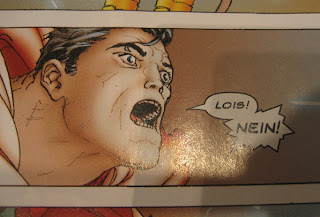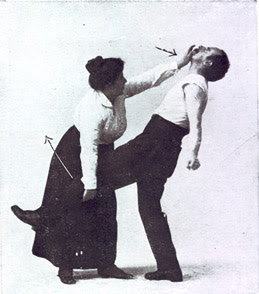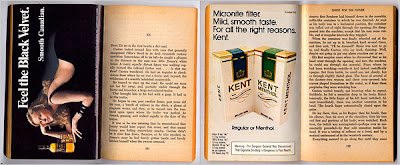Saturday, December 29, 2007
Manga, Ja!

Ron at Galleycat notes a report of Europe's very healthy trade in comics -- and especially manga:
"German and French sales of manga totaled $212.6 million last year," says Jennifer Fishbein of Business Week, "making Europe the largest consumer of manga outside Japan." The news gets better for publishers of the Japanese comic books; in Germany, manga account for nearly three-fourths of all comics sales.
Check out this blog (full of great photos!) from last year on the manga scene in Germany.
Also: I might be the last person to clue in on this, but there is a terrific (and prolific) new blog, Three Percent, dedicated to news of books translated (or not translated) for the US...
Tuesday, December 25, 2007
Holiday Stubble


I've sung the praises of Bizarre Books in the past, and so if you haven't bought it already, now that there's a new and improved edition you really have no excuse. Scouts In Bondage covers some of the same ground, but in glorious full color.
So might I suggest: a copy of Bizarre in the loo, and Scouts on the coffee table?
I still await a book on bizarre subtitles and inane jacket copy. The all-time champ, I'm guessing, would have to be....

Saturday, December 22, 2007
Never Be Rude to An Edwardian

The evidence for my theory? This picture:

Sunday, December 16, 2007
Your Case is Hopeless
Yesterday's Telegraph review notes that someone has actually compiled the late Victorian-era responses from the long-extinct British magazine Boy's Own Paper.
Your Case is Hopeless confines itself to the letters pages and articles of advice in first 21 years of the weekly magazine. In selecting material for this engaging and entertaining book, which reveals the interests and worries of late-Victorian lads, Karl Sabbagh has trawled through some 20,000 letters - or rather responses to letters. Since the actual letters are rarely quoted, the editorial replies can be baffling.
A multiple-question letter triggered the helpful (to the correspondent) answers of 'Yes. No. Perhaps. Try boiled oil.' 'The shots were fired by the balloonist' raises more questions than it answers. More worrying is the reply: 'If you commit a murder, you will certainly be hanged'...
'We have no views on Danish butter,' is an untypical reply, since the editor was not usually short of opinions.... 'Your case is hopeless' was the response to the grammatically challenged lad who enquired whether (or rather, 'weather') it is a poet or his printer who puts punctuation into poems. The editor suggests that the boy could always ask Alfred Tennyson, but, better still: 'Stick to prose.' As for the would-be artist who proudly sent in his sketches, 'You cannot draw.' .... To a lad asking how he can add a human skull to his collection (what else is in the collection, he doesn't reveal) the answer is: 'Why not use your own?' 'We cannot help you with the nose machine,' the editor tells a nasally challenged reader. 'We do not use one ourselves.'.....To another, 'It is a bad time of year for buying alligators.'
I simply must have this book...
Saturday, December 15, 2007
Whodunnit?


Over at the Times, a review of Gavin Stamp's Britain's Lost Cities puts the blame for the destruction of old British urban architecture -- long blamed on the Blitz -- squarely upon the shoulders of city planners:
The religion of the motor car changed all that. Councils dismembered their cities to build ring roads, flyovers and car parks. They used any excuse for demolition — that old buildings had a limited life; that Victorian architecture was at best unfashionable, at worst sinfully ugly; that the mess left by Luftwaffe raids needed tidying up.
The Nazis became convenient scapegoats for plans already under way. Coventry's medieval Butcher Row was razed in 1936, four years before the first bombers flew in. It had become, the Lord Mayor sniffed, “a blot on the city”.... Stamp tells a tale of neglect, incompetence, philistinism and sheer bloody-minded malice, encapsulated in a comment by Herbert Manzoni, the City Engineer and Surveyor of Birmingham from 1935 to 1963: “I have never been very certain as to the value of tangible links with the past,” he said in 1957.
...Their legacy is the desperate sense of loss engendered by Stamp's book, with its 200 stylishly presented archive photographs. I lost count of the number of pictures of smart, historic, charming streets captioned: “Every building in this photograph has since disappeared.”
Sunday, December 09, 2007
Lucky Astrology Mood Scholarship
Ouuuuch.
Next April, the prominent Harvard historian will publish In Search of Our Roots: How 19 extraordinary African Americans reclaimed their past. Gates has studied the ancestry of some of the country's most successful black individuals, including Winfrey, a daytime TV host. He found that 15 had grandparents who owned land, even though just 25 per cent of African Americans had obtained property by 1920. This "astonishing pattern", as Gates described it recently in The New York Times, suggests that promoting home ownership can alleviate contemporary poverty....So what do[es this book] tell us about the roots of success? From a scientific point of view, almost nothing.
The problem lies in two fundamental mistakes.... Let's assume that he really has found an unusually high rate of landowning grandparents among successful African Americans (it is not clear that he has, given that the odds of one grandparent among four having owned land are actually quite high). What about land ownership among the grandparents of less successful African Americans? To suggest that property is important, Gates needs to show that a lack of this legacy contributes to normal folk being, well, normal. In epidemiological terms, he needs to run a "case-control study". But, as Harvard political scientist Andrew Eggers puts it, book sales probably wouldn't be helped by the inclusion of "a few chapters about thoroughly unfamous people"....
An epidemiologist would employ simple mathematics to correct for this problem.... "Most of the time these books are just making intuitions," concludes Gary King, a social scientist also at Harvard. "They're like astrology."
Well, that'll make for some awkward dining in the Harvard Faculty Club.
To be fair to Gates, it's not clear from the article whether their criticism is based on reading an ARC of the book, or on his Times piece. But fans of, ahem, intuitive statistical scholarship will also recall Richard Posner's "evidence" a few years back of a decline in public intellectuals, which was then brilliantly dissected by Caleb Crain in The Nation...
Klickitat Street...

...is just a couple blocks from my house. My kids and I are squarely in the middle of Beverly Cleary territory.
Today's LA Times has an essay and photos on our Portland neighborhood, complete with the sort of freaky Ramona statue.
Bron-Yr-Aur Stomped
The good Reverend is "not a fan" of the group...THE owner of a North Wales cottage immortalised by rock gods Led Zeppelin is pleading for the chance to retire in peace. Church in Wales Vicar John Dale has owned Bron-yr-Aur cottage in rural Gwynedd for the past 35 years and is planning to settle down there in the near future.... [But] the cottage has been inundated with fans, some of whom are hell bent on taking away a piece of memorabilia from the place where lead singer Robert Plant and guitarist Jimmy Page penned their famous third album, Led Zeppelin III, back in 1970....
Rev Dale says some fans have broken into Bron-yr-Aur, taken photos of themselves in front of its now iconic fireplace, and then posted the pictures on the internet.... Another bizarre occurance involved the theft of a sizeable chunk of mortar from the cottage’s front wall – only for it to be returned to Rev Dale in the post a few days later.
“Obviously, the person’s conscience got the better of them,” said Rev Dale.
Saturday, December 08, 2007
First Impressions Are Misleading
Kahane was the kind of roguish publisher that most writers are glad to know exists, but are grateful not to be dependent on. His first successful title was Daffodil (1931) by Cecil Barr, aka Jack Kahane. According to Neil Pearson in his highly entertaining Obelisk: A history of Jack Kahane and the Obelisk Press, the first edition was issued as “3rd impression”, in order to “give the appearance of healthy sales, and so stimulate demand”. The second impression became the “5th”, the third the “9th”, and so on towards a mythical eighteen printings recorded by trusting historians such as Hugh Ford in his seminal book, Published in Paris (1975).
Sunday, December 02, 2007
Crazy Eights
(Hey, a singing drummer!)
Smoked Out
Saturday, December 01, 2007
Stick That In Your Book and Smoke It

I'm on NPR Weekend Edition this morning to talk about my essay in tomorrow's NYTBR on the 1970s practice of placing cigarette ads bound directly into the center of paperback books. Thanks to the 40+ million pages of subpoenaed and leaked internal documents in the UCSF Legacy Tobacco Documents database, I found the paper trail of who was behind it (most of the big paperback publishers, starting with Pocket Books) and how much money was involved (millions).
And no, the authors weren't making a dime.
Lorillard alone ran ads in 540 million (!) paperbacks in a four-year period. They mostly hit pulpy mass-market stuff, but some literary authors got hit too -- including, incredibly, 74,000 copies of The Bluest Eye.
Want the exact names and numbers? I've put the original marketing studies, print run orders, and customer complaints in a timeline below, linked directly into Times and Legacy docs:
28 January 1958: The New York Times reports the formation of the Quality Book Group by Roy Benjamin of the Benjamin Company, along with Pocket Books, Bantam Books, and the New American Library.
4 December 1961: In an early Benjamin Company overture to cigarette companies, Roy Benjamin writes to American Tobacco Company about ad rates for the back cover of Joe Gargiola's Baseball Is A Funny Game.
17 December 1965: The New York Times reports that Dr. Benjamin Spock has lost his fight to keep ads out of Baby and Child Care.
24 January 1966: A BBDO Advertising analysis signals paperback advertising "on a large scale."
3 October 1966: Roy Benjamin contacts Liggett & Myers (maker of Lark cigarettes) suggesting that it sponsor a book titled It's Safe to Smoke.
29 July 1971: An internal memo by Lorillard media director William Santoni lists a 155 paperback title ad buy for August 1971.
10 November 1971: A letter to Benjamin Company by William Santoni of Lorillard orders an ad buy in 74,000 copies of The Bluest Eye.
19 December 1971: The Times reports that, in the wake of a TV ad ban, tobacco ad spending has migrated to other media. It singles out Lorillard's use of paperback ads.
April 1972: deKadt Marketing and Research Inc. conducts a national study that finds paperback ads effective.
11 March 1974: Robert W. Lee of Alexandria, WV complains in a letter to the Tobacco Institute that his 10 and 14 year-old sons have read books containing ads for Kent and True cigarettes. Both are Lorillard products.
11 November 1975: A Lorillard memorandum notes a four-year total of $3 million in expenditures for 540 million paperback ads.
26 September 1983: Philip K. Shaner of the William Esty Company suggests to R.J. Reynolds that they make an ad buy in Dave Marsh's [Book of] Rock Lists.
28 November 1983: A Nicholas Research International study of Salem smokers in St. Louis finds that they "read very little."
30 December 1985: A last gasp. John Heacock of the Heacock Literary Agency contacts Philip Morris offering ad placement in a new paperback-sized hardcover format by SOS Publications of Los Angeles -- "an ideal audience for cigarette advertising." On January 9th Philip Morris V.P. John L. Thompson responds, notes Lorillard's previous use of the format, and declines the offer.
Incidentally, here's one curious discovery that wound up on the cutting floor: I found an October 1986 Philip Morris memo detailing an attempt to plant a book review under a fake name in the San Francisco Examiner.